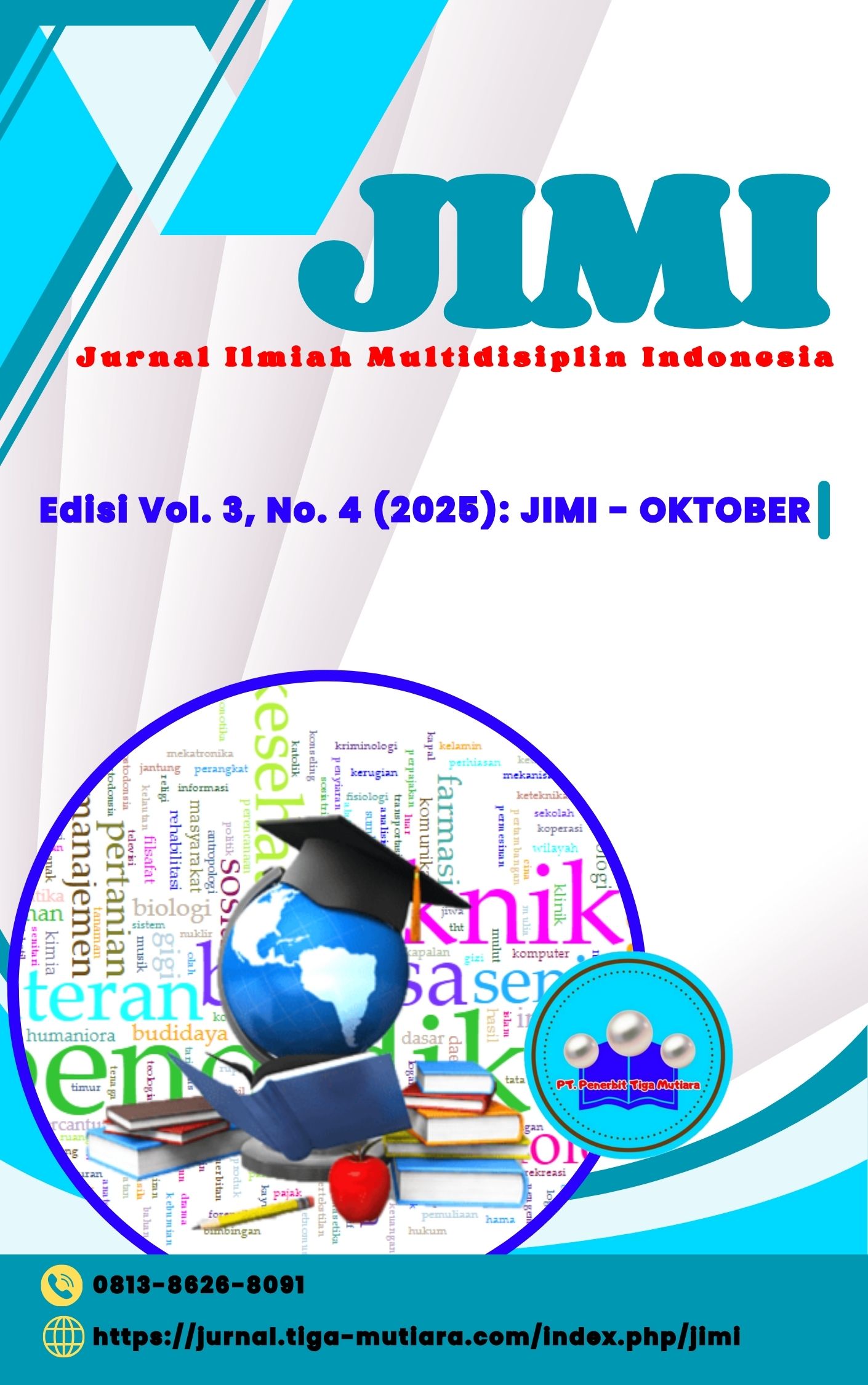Wearable Health Technology dengan AI Prediktif untuk Pencegahan Stunting Anak di Indonesia
DOI:
https://doi.org/10.61404/mutiara.v3i4.438Keywords:
Stunting, Technology, HealthAbstract
Stunting remains a crucial public health issue in Indonesia as it has multidimensional impacts on physical growth, cognitive development, productivity, and the long-term quality of human resources. This study aims to analyze the potential application of predictive Artificial Intelligence (AI)-based Wearable Health Technology in preventing child stunting, with an emphasis on the integration of technology into the health system, socio-cultural interrelations, and ethical dimensions that need to be anticipated. The research employed a qualitative approach through a systematic literature review, analysis of national health policies, and examination of reports on the implementation of digital health technologies related to child health. The results indicate that wearable devices are effective in recording health indicators in real-time, while predictive AI algorithms enable early detection of stunting risks, allowing interventions to be carried out quickly, accurately, and in a personalized manner. However, the success of implementation is highly dependent on the support of the digital health ecosystem, including adaptive regulations, infrastructure readiness, digital literacy among communities, as well as multi-stakeholder collaboration involving the government, medical professionals, the technology industry, and families. This study affirms that the integration of Wearable Health Technology and predictive AI is not merely an additional tool in medical services, but rather a representation of a health system transformation towards a more preventive, predictive, precise, and participatory paradigm. Thus, the utilization of evidence-based digital innovations has the potential to strengthen the effectiveness of stunting prevention programs in Indonesia while accelerating the achievement of national health development targets within the context of technological disruption and global dynamics.
Downloads
References
Aminin, Fidyah, Melly Damayanti, Nurul Aini Suria Saputri, dan Darwitri. “Determinants of Stunting: a Systematic Review.” IJSS: International Journal of Social Science 1, no. 6 (2022): 1065–1076. https://bajangjournal.com/index.php/IJSS/article/view/2425/.
Atamou, Lasarus, Dwi Cahya Rahmadiyah, Hamidah Hassan, dan Agus Setiawan. “Analysis of the Determinants of Stunting among Children Aged below Five Years in Stunting Locus Villages in Indonesia.” Healthcare (Basel, Switzerland) 11, no. 6 (2023): 1–12. https://www.mdpi.com/2227-9032/11/6/810.
Booth, Andrew, Anthea Sutton, dan Diana Papaioannou. Systematic Approaches to a Successful Literature Review. Edisi 2. California: SAGE Publications, 2016.
Braun, Virginia, dan Victoria Clarke. Thematic Analysis: A Practical Guide. London: Sage Publications, 2022.
Creswell, John W., dan Cheryl Poth. Qualitative Inquiry and Research Design: Choosing Among Five Approaches. Edisi 4. Thousand Oaks CA: Sage Publications, 2018.
Erika, Kadek Ayu, Nur Fadilah, Aulia Insani Latif, Nurhikmawaty Hasbiah, Aidah Juliaty, Harun Achmad, dan Anugrayani Bustamin. “Stunting Super App as an Effort Toward Stunting Management in Indonesia: Delphi and Pilot Study.” JMIR Human Factors 11 (2024): 854–862. https://humanfactors.jmir.org/2024/1/e54862/.
Erlyn, Putri, Bachtari Alam Hidayat, Agus Fatoni, dan Herie Saksono. “Nutritional Interventions by Local Governments as an Effort to Accelerate Stunting Reduction.” Jurnal Bina Praja 13, no. 3 (2021): 543–553. https://jurnal.kemendagri.go.id/index.php/jbp/article/view/1134/.
Halwa, Elfa Nuzila. “Digital Communication of Stunting Prevention: A Qualitative Analysis on Instagram.” ATH-THARIQ: Jurnal Dakwah dan Komunikasi 9, no. 1 (2025): 98–109. https://e-journal.metrouniv.ac.id/ath_thariq/article/view/10263/.
Hasdyna, Novia, Rozzi Kesuma Dinata, Rahmi, dan T. Irfan Fajri. “Hybrid Machine Learning for Stunting Prevalence: A Novel Comprehensive Approach to it’s Classification, Prediction, and Clustering Optimization in Aceh, Indonesia.” Informatics 11, no. 4 (2024): 1–32. https://www.mdpi.com/2227-9709/11/4/89.
Indrisari, Emilda, Hidayat Febiansyah, dan Bambang Adiwinoto. “A Systematic Literature Review on the Application of Machine Learning for Predicting Stunting Prevalence in Indonesia (2020-2024).” Jurnal SISFOKOM 14, no. 3 (2025): 277–283. https://jurnal.atmaluhur.ac.id/index.php/sisfokom/article/view/2366/.
Kurniawati, Dini, Sutanto Priyo Hastono, Iko Safika, dan Wiji Wahyuningsih. “Geographically Weighted Regression Model of Stunting Determinants in Indonesia.” Journal of Maternal and Child Health 10, no. 3 (2025): 140–152. https://thejmch.com/index.php/thejmch/article/view/1193/.
Namirembe, Grace, Robin Shrestha, Julieta Mezzano, Lynne M. Ausman, Dale Davis, Kedar Baral, Shibani Ghosh, Gerald Shively, dan Patrick Webb. “Effective Nutrition Governance is Correlated with Better Nutrition Outcomes in Nepal.” BMC Pediatrics 21, no. 1 (2021): 434–443. https://plu.mx/plum/a/?doi=10.1186/s12887-021-02898-4&theme=plum-bigben-theme.
Nurfajriani, Wiyanda Vera, Muhammad Wahyu Ilhami, Arivan Mahendra, Muhammad Win Afgani, dan Rusdy Abdullah Sirodj. “Triangulasi Data dalam Analisis Data Kualitatif.” Jurnal Ilmiah Wahana Pendidikan 10, no. 17 (2024): 826–833. https://jurnal.peneliti.net/index.php/JIWP/article/view/7892.
Permatasari, Tria Astika Endah, Yudi Chadirin, Ernirita Ernirita, Anisa Nurul Syafitri, dan Devina Alifia Fadhilah. “The Accuracy of a Novel Stunting Risk Detection Application Based on Nutrition and Sanitation Indicators in Children Aged Under Five Years.” BMC Nutrition 11, no. 1 (2025): 93–103. https://pubmed.ncbi.nlm.nih.gov/40361193/.
Pramana, A.A. Gde Yogi, Haidar Muhammad Zidan, Muhammad Fazil Maulana, dan Oskar Natan. “ESDS: AI-Powered Early Stunting Detection and Monitoring System using Edited Radius-SMOTE Algorithm.” Machine Learning (2024): 1–14. https://arxiv.org/abs/2409.14105.
Ratnasari, Ahmad Jurnaidi Wahidin, dan Tahta Herdian Andika. “Deteksi Dini Stunting pada Anak berdasarkan Indikator Antropometri dengan Menggunakan Algoritma Machine Learning.” Jurnal Algoritma 21, no. 2 (2024): 378–387. https://jurnal.itg.ac.id/index.php/algoritma/article/view/2122/.
Sahamony, Nur Fitriyani, Terttiaavini, dan Harsih Rianto. “Analisis Perbandingan Kinerja Model Machine Learning untuk Memprediksi Risiko Stunting pada Pertumbuhan Anak.” MALCOM: Indonesian Journal of Machine Learning and Computer Science 4, no. 2 (2024): 413–422. https://journal.irpi.or.id/index.php/malcom/article/view/1210/.
Sayekti, Ignatia Maria Sri. “Kemenkes Umumkan Penilaian Indeks Kematangan Digital dan Resource Center Transformation.” Pressrelease.id. Last modified 2023. https://pressrelease.kontan.co.id/news/kemenkes-umumkan-penilaian-indeks-kematangan-digital-resource-center-transformation#:~:text=Pada 2023%2C jumlah provinsi dan kabupaten/kota yang,provinsi%2C 10 dinkes kabupaten/kota%2C dan 10 rumah.
Sihotang, Widya Yanti, Victor Trismanjaya Hulu, Frans Judea Samosir, Putri Yunita Pane, Hartono, Putranto Manalu, Masryna Siagian, dan Hajijah I. L. Panjaitan. “Determinants of Stunting in Children Under Five: a Scoping Review.” The Indonesian Journal of Nutrition 12, no. 1 (2023): 9–20. https://ejournal.undip.ac.id/index.php/jgi/article/view/53766/.
Siramaneerat, Issara, Erni Astutik, Farid Agushybana, Pimnapat Bhumkittipich, dan Wanjai Lamprom. “Examining Determinants of Stunting in Urban and Rural Indonesian: a Multilevel Analysis Using the Population-Based Indonesian Family Life Survey (IFLS).” BMC Public Health 24, no. 1371 (2024): 1–13. https://bmcpublichealth.biomedcentral.com/articles/10.1186/s12889-024-18824-z.
Snyder, Hannah. “Literature Review as a Research Methodology: An Overview and Guidelines.” Journal of Business Research 104 (2019): 333–339. https://www.sciencedirect.com/science/article/pii/S0148296319304564.
Subratha, Hesteria Friska Armynia, dan Km Tri Sutrisna Agustia. “Determinants of Stunting Among Toddlers: a Systematic Literature Review.” WMJ: Warmadewa Medical Journal 9, no. 2 (2024): 50–56. https://ejournal.warmadewa.ac.id/index.php/warmadewa_medical_journal/article/view/8067/.
Sudiati, Listiarini Edy, Wahyu Aditama, dan Daniel Alfa Puryono. “IoT-based Stunting Education and Early Detection System for Stunting-Free Indonesia.” East Asian Journal of Multidisciplinary Research 2, no. 12 (2023): 4855–4866. https://journal.formosapublisher.org/index.php/eajmr/article/view/6767/.
Team Redaksi. “Bank Dunia Menyetujui Dukungan untuk Memperluas Upaya Indonesia Mengurangi Stunting di Masa Kecil.” World Bank Group. Last modified 2023. https://www.worldbank.org/in/news/press-release/2023/06/27/world-bank-approves-support-to-expand-indonesia-s-efforts-to-reduce-childhood-stunting.
———. “Indonesia Berbagi Pengalaman Intervensi Stunting di Human Capital Summit di Laos.” Sekretariat Wakil Presiden. Last modified 2024. https://stunting.go.id/indonesia-berbagi-pengalaman-intervensi-stunting-di-human-capital-summit-di-laos/.
Wicaksono, Ardy, Deny Prasetyo, Yulaikha Mar’atullatifah, Dwi Utari Iswavigra, Himmatunnisak Mahmudah, dan Ayun Hapsari. “Data Analysis and Explainable Machine Learning for Stunting Prediction.” Journal of Artificial Intelligence and Legal Technology 1, no. 1 (2025): 35–44. https://journal.sah.co.id/index.php/JAILT/article/view/4/.
Downloads
Published
How to Cite
Issue
Section
License
Copyright (c) 2025 *Yustinus

This work is licensed under a Creative Commons Attribution-ShareAlike 4.0 International License.













